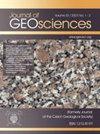Janjevo(科索沃)Cu-Bi-Ag±W矿石的矿物学和地球化学研究:铋磺酸盐矿物学和铋在贱金属硫化物中的分布
IF 1.3
4区 地球科学
Q3 GEOCHEMISTRY & GEOPHYSICS
引用次数: 0
摘要
本工作对科索沃Trepça矿带Janjevo的Cu–Bi–Ag±W矿石进行了矿物学和地球化学研究。该位置表明Kizhnica–Hajvalia–Badovc矿田内存在一种新型的Bi–Cu±Au矿化,包括以前在科索沃和Vardar带这一地区未描述的Cu–Bi±Ag±As磺盐共生作用。基于显微镜、微探针和激光烧蚀电感耦合等离子体质谱研究,讨论了Bi–Pb±Cu±Ag和Cu–Bi±Ag±As磺酸盐、硫化物和伴生矿物的化学组成,以及它们的共生关系和微量元素在主要矿物中的分布。Janjevo的Cu–Bi–Ag±W热液成矿形成于四个阶段:(1)早期贱金属阶段、(2)铋阶段、(3)主阶段和(4)晚期。早期贱金属阶段以黄铁矿、闪锌矿I、黄铜矿I、方铅矿I、布尔诺岩I、四面体I、菱铁矿和石英为代表。铋阶段包括毒砂I、löllingite、天然铋、方铅矿II、黄铜矿II、四面体II、石英、菱铁矿和Bi–Pb±Cu±Ag磺盐:铋矿、亚辉橄榄岩、克鲁普海特、共钠石和古斯塔维特。主要阶段以黄铜矿III、四面体族矿物(四面体和tennantite)III、方铅矿III、闪锌矿II、毒砂II、布尔诺矿II和菱铁矿为代表。与方铅矿IV、菱铁矿和石英相关的Cu–Bi±Ag±As磺盐(磷铈矿、铜砷铁矿、硫铁矿和未知相:AgCuBiS3)形成于最后的低温晚期。GGIMFis地热测量法在闪锌矿上的应用给出了以下闪锌矿沉淀温度:闪锌矿I为220–272°C,闪锌矿II为160–190°C。研究结果表明,除了Janjevo Cu–Bi–Ag±W矿石中的大量铋磺酸盐外,铋还被掺入了贱金属硫化物和毒砂中。铋的主要载体是毒砂I,它已经开始了铋阶段的结晶。本文章由计算机程序翻译,如有差异,请以英文原文为准。
Mineralogical and geochemical studies of Cu-Bi-Ag±W ores from Janjevo (Kosovo): Insights into the Bi sulfosalt mineralogy and the distribution of bismuth in base metal sulfides
This work presents a mineralogical and geochemical study of Cu–Bi–Ag ± W ores from Janjevo in the Trepça Mineral Belt in Kosovo. This locality indicates a new type of Bi–Cu ± Au mineralization within the Kizhnica–Hajvalia–Badovc ore field, including Cu–Bi ± Ag ± As sulfosalts paragenesis previously not described in Kosovo and in this part of the Vardar Zone. Chemical composition of Bi– Pb ± Cu ±Ag and Cu – Bi ± Ag ± As sulfosalts, sulfides, and associated miner - als, as well as their paragenetic relationships and the distribution of minor and trace elements in main ore minerals, are discussed based on microscopy, microprobe, and laser ablation inductively coupled plasma mass spectrometry studies. The Cu–Bi– Ag ± W hydrothermal mineralization in Janjevo was formed during four stages: (1) Early base metal stage, (2) Bismuth stage, (3) Main stage, and (4) Late stage. The Early base metal stage is represented by pyrite, sphalerite I, chalcopyrite I, galena I, bournonite I, tetrahedrite I, siderite, and quartz. The Bismuth stage includes arsenopyrite I, löllingite, native bismuth, galena II, chalcopyrite II, tetrahedrite II, quartz, siderite, and Bi – Pb ± Cu ± Ag sulfosalts: bismuthinite, aikinite, krupkaite, cosalite, and gustavite. The Main stage is represented by chalcopyrite III, tetrahedrite group minerals (tetrahedrite and tennantite) III, galena III, sphalerite II, arsenopyrite II, bournonite II, and siderite. The Cu– Bi ± Ag ± As sulfosalts (pearceite, cupropearceite, wittichenite, and an unknown phase: AgCuBiS 3 ) associated with galena IV, siderite, and quartz were formed in the final low-temperature Late stage. The application of GGIMFis geothermometry on sphalerite gives the following sphalerite precipitation temperatures: 220–272 °C for sphalerite I and 160–190 °C for sphalerite II. Presented results show that in addition to numerous Bi sulfosalts in Janjevo Cu –Bi–Ag ± W ores, bismuth has been incorporated into base metal sulfides, as well as arsenopyrite. The main carrier of bismuth is arsenopyrite I, which has started the crystallization of the bismuth stage.
求助全文
通过发布文献求助,成功后即可免费获取论文全文。
去求助
来源期刊

Journal of Geosciences
GEOSCIENCES, MULTIDISCIPLINARY-MINERALOGY
CiteScore
2.30
自引率
7.10%
发文量
15
审稿时长
>12 weeks
期刊介绍:
The Journal of Geosciences is an international peer-reviewed journal published by the Czech Geological Society with support from the Czech Geological Survey. It accepts high-quality original research or review papers dealing with all aspects of the nature and origin of igneous and metamorphic rocks. The Journal focuses, mainly but not exclusively, on:
-Process-oriented regional studies of igneous and metamorphic complexes-
Research in structural geology and tectonics-
Igneous and metamorphic petrology-
Mineral chemistry and mineralogy-
Major- and trace-element geochemistry, isotope geochemistry-
Dating igneous activity and metamorphic events-
Experimental petrology and mineralogy-
Theoretical models of igneous and metamorphic processes-
Mineralizing processes and mineral deposits.
All the papers are written in English, even though they may be accompanied by an additional Czech abstract. Each contribution is a subject to peer review by at least two independent reviewers, typically at least one from abroad. The Journal appears 2 to 4 times a year. Formally it is divided in annual volumes, each of them including 4 issues.
 求助内容:
求助内容: 应助结果提醒方式:
应助结果提醒方式:


